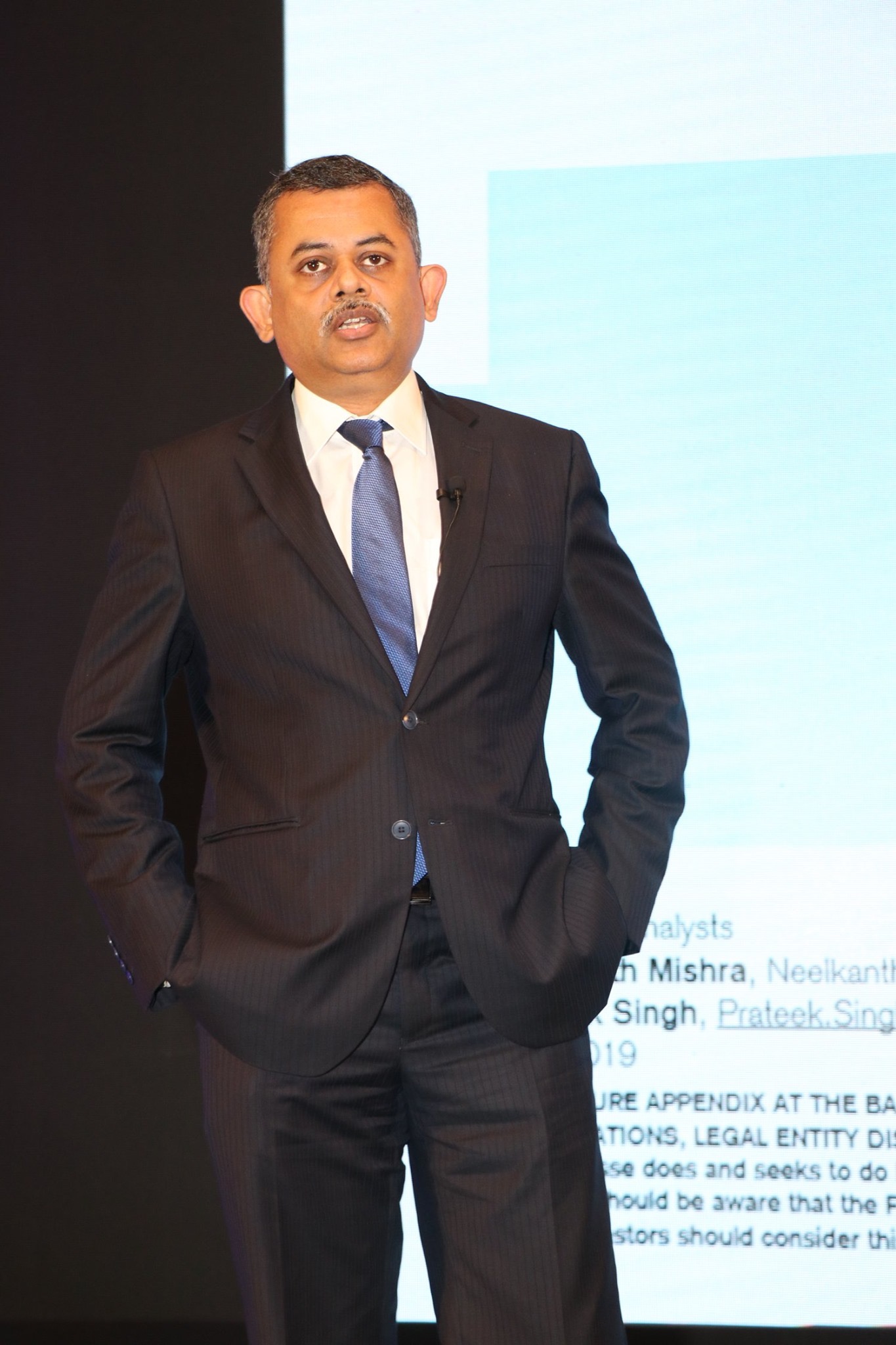- August 20, 2019
- Posted by: Shivani Chopra, CFA
- Category:BLOG, Events
Contributed by Soham Das, CFA
On 29th June 2019, Neelkanth Mishra took the stage to speak and shed light on the nature of the current economic slowdown. His topic, “A cyclical and not a structural slowdown” was written boldly on the top of an otherwise bland slide, with a blue patch running across it. Mr. Mishra, the Managing Director of Equity Research at Credit Suisse, brought a robust economic perspective to uncover the nascent trends in the Indian economy.

He started with a clear acknowledgement of the slowdown Indian economy is in. Investing community is reeling from a “sense of crisis”, he alluded to the crisis in Indian non-banking financial companies (NBFC). Yet he predicted that the slowdown is a cyclical one and not a structural one. However, he added ominously- that pain is not over yet. He pointed, that Chinese will not expect an 8% growth anymore. He added, that there is a structural slowdown and their size of the economy is a much tougher anchor to get rid of. “All “they” (read: China) are aiming for right now is 6%”, Mr. Mishra elaborated and added, “there is acknowledgement in the government circles, that 4% is where they will glide to”. Drawing a sharp contrast to our neighbor, he assured that India should be back expecting 8-8.5% in the next fifteen to eighteen months, albeit not without significant pain in the short term.
Surprisingly, Mr. Mishra observed a very astute and often ignored factor – that of state capacity.
His logic was ironclad. Earlier when India was 15th or 20th largest nation in the world in terms of GDP, there was a lot of lee-way in not building deep reforms. He reminded that India plucked low hanging reform fruits and triggered growth. But as India grows with a $3Tn economy keeping and sustaining an 8% growth will take a lot more effort from government, Mr. Mishra reminded the audience. Achievable? Yes, but will need work, he added cautiously. Indian government needs to expand its state capacity to deliver the next stage of reforms.
He further added, that while India’s tax to GDP is among the lowest in the world, the tax rate of the formal economy was at the highest levels, almost at par with OECD countries. This constrains the government to improve its “presence” in areas where it needs to. As a result the capacity of government to deliver the public goods is constrained.
Broadly, Mr. Mishra structured his talk around three “pillars”- an acknowledgement of the slowdown, reasons why the slowdown is a “phase”, which too shall pass and the risks which can seriously jeopardize the unfolding growth story of India.
Pillar 1: India has slowed down
- Simmering Slowdown: Growth has clearly slowed and continued to weaken in Q1’19. The slowdown touched high value discretionary first, moving to low-value discretionary items and is firmly into the staples as well. However, the nature of the slowdown is not that of a “raging” forest fire, but more that of a slow-burning kind. The broad based indicators like fast moving consumer goods demand, oil and power demand etc. have tapered off.
- Fading Effects: An under-appreciated phenomenon in Indian macro-economic analyses is the effect of Pay Commissions and its linkage to consumption. Each Pay Commission kickstarts a fresh cycle of consumption, as arrears are paid. Furthermore, instead of a one-time spike in consumption, such a revision creates a new normal for an extended period of time. Mr. Mishra observed that the effects of the 7th Pay Commission boosted consumption is fading,as increasing number of Indian states implement the recommendations of the commission. The last state to implement the recommendations was Maharashtra, which completed in Jan 2019As a result, we are right now at the fag end of the cycle and the consumption boost afforded by the Pay Commission is now waning.
- Credit Plumbing not functional: Credit creation has stopped with public sector banks (PSB) relinquishing their mandate to lend with government trying to reduce the dependence of economy on them, just like it successfully did in telecom with BSNL and MTNL. The vacuum left by PSBs were filled with NBFCs and Private Sector Banks. But with Private Sector Banks not wishing to grow beyond 2x GDP and NBFCs faltering in their stressed situation, credit supply has come to a halt. As a result, the growth in money supply(M3) has lagged GDP growth for the last 2 years.
- High Costs, Low Inflation: The only way, to boost credit growth is to cut the cost of credit, which Mr. Mishra eloquently pointed out is still 200-250bps higher than it should be. The key thrust of his logic was simple – even with inflation falling drastically, the rate of interest has barely budged.
Pillar 2: Cyclical and Not Structural
- Supply Chain Bullwhip: A slight fall in consumer demand creates huge fluctuations down the supply chain, which is what we are feeling right now. He posited that when consumption demand picks up, the “whip” will move the other way.
- Good omens in under-reported data: Financial savings is at a 9-year high and this is highly under-reported. Mr. Mishra, makes the point by drawing a contrast between two charts, one that is reported by private players and the other is government reported. What do the charts show? One chart, clearly showed a bar graph rising higher and higher with every successive period since 2014, with the last and the latest bar shooting up significantly. The metric? Mutual Fund Flows. Mutual Fund flows have consistently risen in the last few years and significantly accelerated in the last 5-6 quarters. The government reported numbers on financial savings are highly skewed and under-report the statistics with barely any ‘movement’ since 2014.
- Encouraging Private Capex Activity: Private capex is holding up and is expected to continue. While the growth mix of Indian economy is shifting towards investments, but the rate of capital formation in proportion to GDP has fallen.
Pillar 2.5: What government has to keep doing, to keep the growth on track
- Invest in roads: Roads have huge positive externalities, building and spurring growth in a region. Drawing comparisons between two villages, one which benefited from road linkages and one which didn’t, Mr. Mishra made it amply clear the reason why roads are catalysts of growth. Road linkages spurred an increase in land prices, access to urban markets and increase in gainful employment. As a result, he articulated that investing in road network has the ability to spur growth in a region.
- Invest in energy production: While China has a rural penetration of 95% in white goods, India has to reach that level and good quality electricity generation is prime need of the hour. Mr. Mishra later on added another dimension of the current energy paucity that India faces. With two thirds of Indian household dependent upon firewood, crop residue etc. to cook food, the loss to public health, environment and productivity is substantial.
- Invest in mobile connectivity: While our mobile penetration has skyrocketed, we are still 6-7 years behind Indonesia. With increasing primacy of data, any investment in connectivity will play out along Metcalfe’s Law of networks. Mr. Mishra highlighted that as India’s usage of phone screen time and social media explodes, so will growth opportunity by forming informal job networks. He posited, by 2020 about 96% of Indian population will be connected.
Pillar 3: Addressing risks to prevent the cyclical slowdown from becoming structural
- Government needs to invest significantly in energy production. India needs more energy and more dense forms of energy to facilitate growth. He articulated that, energy consumption and growth are highly interlinked, as productivity can be improved only if energy consumption and thus production increases. Mr. Mishra articulated that even though many would disagree, India still needs more coal fired thermal power plants as he quoted statistics on Indian per capita energy usage being roughly 31% of world average.
- Mr. Mishra rounded off, his talk by pithily summarizing the current credit crisis as that of the case of only one and half out of 5 credit guns firing- that of the private banks and “half” of NBFCs. The Public Sector Banks are growing significantly below industry needs and NBFCs/HFCs contributing to only 30% of credit demand in Indian markets.
- Growing Energy Bills: The energy import bill must be paid through by exports or capital inflows. But if prices are to keep growing at their historical pace of 2-4%, by 2021, the energy bill will be $165B. As exports are faltering and Indian capital inflows close to structural limits, energy costs pose a significant challenge.
Mr. Mishra, in summary, had a highly interesting story to tell. A story where Indian economy has faltered but not yet “out”, slowed down but not ground to a screeching halt, has lost momentum, but has not crashed. Credit and demand have slowed down; macro-economic policies that were poorly coordinated has added fuel to the fire.
Yet, he painted a picture of silent optimism, where he brought out statistics, made perceptive arguments and drew a vivid picture about the silent transformation that is currently underway in India. Be it from growing road networks to mobile networks, to energy networks. Be it increasing usage of cleaner fuels for household use or the agricultural surplus India is enjoying today. Yet, he cautioned, India also faces significant risks in the intermediate term. Exports are faltering, energy production has stagnated and financial system capacity is significantly constrained today.
For India, to break away from the current “orbit” of growth and push itself into a new normal, the government has to take care of energy production and energy costs. No more, can India rely only on imported energy. If it must, then it has to find ways to tackle the rising energy import bill. It was not difficult for the audience to understand what was at stake, if it doesn’t take care of the current energy drought. The conclusion was stark. A paucity in energy will keep India trapped in a paradigm of lower productivity than what can be achievable.
Like a fantastic story teller, Mr. Mishra weaved a narrative through dry economic facts, and painted a picture that spoke of his cautious optimism about the future of India.
Link to the session presentation – https://www.cfasociety.org/india/Presentations/A%20Cyclical%20not%20structural%20slowdown-MAW%2029th%20June-%20Neelkanth%20Mishra.pdf










[…] in the last month or so in India. Some recent analyses are here (Shankkar Aiyar), here (Niranjan), here (Neelkanth) and here (Ashima Goyal […]